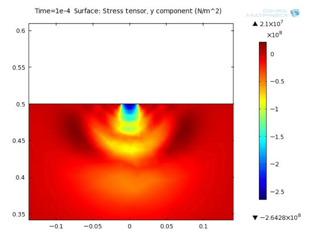AmericanChemicalSociety.com
Reports: ND9 49080-ND9: Boundary Wear Induced by Flow of Concentrated Suspensions
Jeffrey F. Morris, PhD, City College of New York
Wear associated with motion of liquids highly loaded with solid particles may be a desirable as a method of polishing or may be an undesirable consequence in slurry transport. In either case, the coupling between the rheology and bulk motions of the slurry and the tribological phenomena taking place at the surface of a solid is a multiscale phenomenon. This multiscale aspect provides a valuable new direction in study of dense suspension flow, an established area of study in the research group of the investigator. This problem allows exploration of the impact of prior results or readily obtained results from existing simulation tools upon molecular scale phenomena. It opens an avenue to the study of the dynamical material science questions in mixture flows with classical materials questions.
A snapshot of the multiscale question is useful. Between the bulk slurry scale where vast numbers of particles interact to the molecular scale (in the boundary) where plastic deformation and removal of material take place, we have identified two "interfaces" associated with a classic tribological problem. Specifically, the elastohydrodynamic lubrication problem, with eventual breakdown of the thin liquid film and plastic surface deformation, for a single particle couples the questions of bulk phenomena on one side to molecular scale on the other. This single body is representative of any particle in the slurry, but stresses due to the stochastic flow-driven interactions with its neighbors drive it into contact with the wall, and scales of interest rapidly decrease to nanometer scale for even millimeter-scale particles. This single-body thus acts as a transducer between bulk stress fields which we already know in statistical form from prior work, to the thin film and solid-solid contact deformation of classical tribology. We have thus focused significant attention on development of numerical tools for study of the dynamics of a wear particle interacting with a slurry stress field, with the goal being to be able to predict the detailed boundary wear tracks of individual particles.
The numerical efforts are coupled with experiments of two
types:
1) The first establishes the particle motions in a
bulk flow inducing boundary wear, with measurement of the wear. A contraction
geometry is used.
2) The second is surface deformation analysis which focuses on developing
understanding of the surface damage associated with given force levels, imposed
by a miniature Instron-type device, the Textrure Analyzer HD) on a wear particle at conditions
comparable to flow situations. Analysis by microscopy (SEM and AFM) is
performed.
Figure 1. Contraction geometry: dense suspension
flow and wear experiments.
Left to right:
the flow geometry with 300 micron glass beads and 8 mm
narrow width,
and particle tracks for individual
beads. Flow is left to right.
Figure 2. Von Mises stress under rigid particle moving normal and
tangential to (left to right)
a nylon substrate.
In Figure 1, images showing a dense (50 volume % solids) glass-particle slurry
with beads of 300 microns in a contraction geometry with narrow opening of 8
mm, followed by particle tracks over the entire flow, as well as the detailed
tracks of individual particles from a portion of the flow. This provides direct information
on the motion of near-boundary particles from which a
statistical picture of the flow phenomena associated with boundary wear are
deduced. The structure of the film thickness for a particle moving both
tangentially and normal to the wall shows expected nonmonotonic
boundary deformation, and coupling to the simulation of many-body suspensions
is underway to predict damage by many (hundreds) of particles at a surface in
extended time of flow.
Figure 2 shows the stress for a rigid particle moving normal to and
tangential to a substrate (nylon).
The experimental studies shown in Figure 1 formed part of
the PhD thesis work of Dr. Sandeep Kulkarni, and was instrumental in his entering professional
employment in the petroleum field with Halliburton (Pune,
India; July 2010) and his work has been followed by Clement Thorey,
an intern student from Lyon, France. A new PhD student will begin work on the topic
this year, with an emphasis on the role of fluid (suspension vs slow granular flow in abrasive wear). The numerical effort is led by Dr. Parisa Mirbod, who is working to
couple to the surface analysis. This has expanded Dr. Mirbod's
technical range into material science areas, and exposed her to a range of
applications of her background in lubrication phenomena. The PI and his group's efforts to
explore the connection of dispersion flows to material science questions has
benefited greatly from the support of the PRF.


Copyright © American Chemical Society


